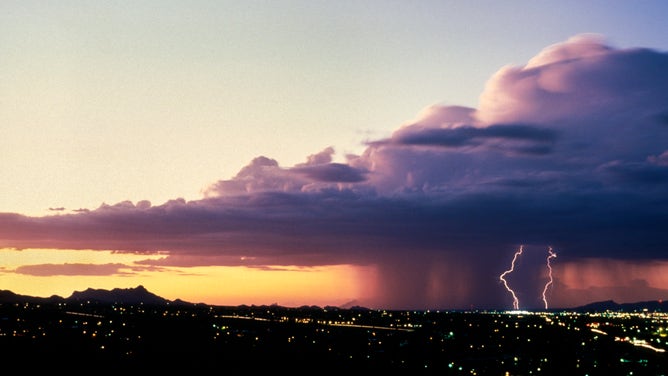What is a heat burst?
A quick and freak heat event can occur when a thunderstorm collapses overhead.

Lightning and rain from collapsing cumulonimbus clouds in the late afternoon in Arizona.
(Wild Horizons/Universal Images Group / Getty Images)
It's a typically hot evening in the desert or the Midwest, and the sun has set or is just about to, when all of a sudden, the wind starts blowing seemingly from nowhere. The temperature becomes noticeably warmer -- perhaps several degrees warming in just a few minutes!
You've just experienced a heat burst -- or essentially, what happens when a thunderstorm collapses overhead as conditions on the ground are just right.
Thunderstorms draw their energy from moist, unstable air given an atmospheric lift, be it by terrain, an approaching storm, or other mechanisms. Updrafts lead to cooling, condensation, moisture, rainfall, and eventually the thundering booms from lightning.
But once the storm begins to decay and loses its updraft -- now the downdrafts from the falling rain take over. And if conditions below the storm cell are hot and dry, the rain will begin to evaporate. Evaporation takes energy, which will initially cool the air and then increase its rate of descent as the air gets heavier.
At some point along its journey, the dry air wins the battle, and all the rain evaporates, leaving behind a dry, sinking burst of air. Once the rain is gone, the cooling process stops and reverses to a warming process because sinking air becomes warmer and even drier still due to compressional heating.
Eventually, this gust of hot, dry air will reach the ground, resulting in a sudden burst of wind and heat (along with a significant dip in the dew point and relative humidity.)
One such heat burst hit Pueblo, Colorado, on June 18, 2021. At 8 p.m., it had dropped to 91 degrees after a scorching 103-degree afternoon, but suddenly a southwest wind picked up, and the temperature quickly rose to 95 degrees with a peak gust of 62 mph. Then 90 minutes later, it was down to 83 degrees with much calmer winds.
In 2011, a massive heat burst in Wichita, Kansas, boosted the temperature from 85 to 102 degrees in 20 minutes just after midnight as winds hit 45 mph.
So sometimes, even after thunderstorms have seemingly given their last gasp, that gasp can still pack quite a punch!